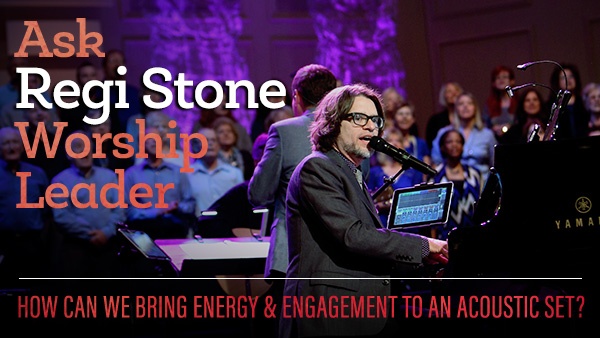
QUESTION: For leading a low-key acoustic worship set, what are some ways to increase the congregational energy and engagement without using the sound system and loud instruments?
REGI: This is an intriguing question.
In many contemporary services, the worship music starts off with a bang with blazing guitars and synchronized lights. While a low-key acoustic set is often the exception and not the rule, it can be very effective.
This idea is fresh on my mind because my friend, Dave Cleveland, and I just recorded a continuous 40-minute, acoustic worship experience called Holy Spirit, Come.
Here are six things to consider when crafting an acoustic worship experience:
1. THE SONG
Over the years, we’ve learned that a song doesn’t need to be loud to be intense. When you’re looking for congregational energy and engagement, don’t start with the volume knob. Rather, begin with the song choice.
The song needs to be believable. It needs to be simple. And it needs to be memorable and easy to learn. For example, people love to sing the hymn standard, “Great is Thy Faithfulness.” They don't hold back. The verse is simple and the chorus rings out. Try it out, and you'll see that anyone can sing it. There are no odd rhythms, and the lyrics are timeless.
2. THE BEAT
Another key element in acoustic worship is the rhythm section—especially percussion. Percussion is more than drums...it’s whatever is “struck” to keep time. This can include piano keys and guitar strings. Together with the bass guitar, a consistent beat invites the congregation to sing with confidence. It doesn’t have to be loud, but it does have to be clear. You might be tempted to do without a rhythm section in a stripped-down worship setting. Whatever you do, don’t lose the beat!
3. THE MELODY
When the accompaniment is simpler, the voices of your worship team and choir are more prominent. Especially in an acoustic setting, the melody needs to be clear and unambiguous. The worship leader and/or the choir should consider singing in unison, especially at the beginning of the song. Harmony parts can be added after the congregation begins singing with confidence.
4. THE VOICES
In moments where the congregation’s voices are soaring, it may be the perfect time for the instruments to drop out all together. Especially in the Psalms, it’s clear that the Lord enjoys horns, stringed instruments, and percussion instruments in worship. But God created music as the language of the spirit, and nothing pleases the Father more than hearing the grateful voices of his children.
When singing a hymn, I sometimes direct the women to sing a verse followed by all voices on the chorus. Then I tell the men sing a verse and so on. You get the point. I wish I could say there are three things that will work in every church, but it isn't so. Every congregation is different, so you’ll have to walk with them to discover what works best.
5. THE WORD
While the words of the worship leader are important to engage the congregation, I’ve learned that God’s Word is even more transformative.
Recite a scripture verse as a prelude to a song. Have everyone read a passage aloud. Not only does this help the congregation feel more comfortable being heard in the space (there’s no musical talent required to read!), declaring God’s Word saturates the sanctuary with God’s truth. In an acoustic setting, I can invite them to declare a specific scripture right before a chorus or prior to a powerful moment in the song.
6. THE SOUND SYSTEM
Finally, while doing an acoustic set may not require the same finesse at the soundboard as mixing a more complicated group of singers and musicians, proper engineering of the vocalist and instruments is still important.
Don’t give your sound person the day off just because there’s not as much to do. It’s as essential to amplify soft sounds as it is to attenuate the volume of a stage full of singers and players.
* * *
I enjoy leading a stripped-down acoustic set as much as I do leading worship with full choir and orchestra. One is not better than the other; they’re simply different.
If an acoustic team is all you’ve got, then I encourage you to use what you have to the best of your ability. The Lord will bless your faithfulness.
If you have more resources, I would encourage you to consider doing a stripped-down acoustic service now and then to bring immediacy and intimacy to the experience. Good worship service planning can make an small, acoustic set as effective as a stage full of singers and musicians--if not more.
I hope this helps!
--Regi
PS: Click here to preview dozens of great selections from Discover Worship that are perfect for small, acoustic band settings.






